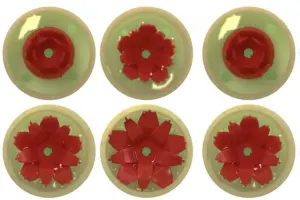Natural creatures such as chameleons and cephalopods possess remarkable skin appendages, which morph and change their functionality. For instance, chameleons can alter their skin colors for camouflage, while cephalopods stretch ink-filled sacs called chromatophores to change their skin patterns. They use liquid mechanisms to control these changes, creating visually stunning patterns and textures that can aid in temperature regulation and adhesive control. These natural mechanisms are unique in offering multiple functionalities, like color, temperature, texture, and adhesion changes. Moreover, they operate with very low power compared to conventional light-emitting semiconductor devices.

Inspired by these natural mechanisms, researchers at the University of Illinois Urbana-Champaign have developed a new type of energy-efficient display that uses bendable fins and fluid-filled pixels to create optical and infrared light displays. This innovative technology can change color, display information, and even transmit hidden messages through infrared radiation.
The researchers drew inspiration from the way otters and beetles bundle their hairs for temperature regulation, investigating flexible appendages that flap due to the hydrodynamic action of liquid droplets. They created ultra-soft fins attached at the base to fluid-filled cells, known as “flap4”. Arranged in arrays, these cells form a pixelated skin, with each cell individually controlled by liquid volume through a pore connected to a fluid network.
These flapping fins can switch between two stable states: straight and bent. The transition is regulated by the drainage rate from a hole next to the fin. Slow drainage leads to the fin flapping to the narrow side (N mode), while a high drain rate results in the fin flapping to the wide side (W mode).
Using these flap4 cells, the researchers created a soft, multipixel display where each pixel could be individually controlled. By contrasting the fin color with the cell’s background and using droplets of different temperatures across the fin, optical/infrared (IR) multispectral signaling is possible.
Led by Professor Sameh Tawfick of Mechanical Science and Engineering, the team exploited the principle of elasto-capillarity, which examines the interplay between elastic and capillary forces. The team designed miniature pixels, a few millimeters in size, composed of flexible polymer fins that bend in response to fluid volumes. The fluid in these pixels is controlled by a system of tiny pumps, allowing for volume and temperature changes, which modify the behavior of the fins in a manner similar to a flip clock.
By precisely controlling the fluid volume, the team can maneuver the fins into various orientations, allowing the creation of different images and even complex motions like a blooming flower. Additionally, the technology has a dual-signal capacity, with the ability to deliver two messages simultaneously – one visible to the naked eye, and another detectable only through an infrared device.
However, the technology is currently limited by the absence of commercially available pumps for controlling the pixel fluids and its optimal operation only in a horizontal position due to gravity. The researchers have proposed a solution to the latter issue, suggesting that reducing the droplet size by five times could render the liquid droplets immune to the effects of gravity.
Despite these challenges, Tawfick is optimistic about the future of this technology. The study demonstrates the functionality of ultrasoft fins under capillary hydrodynamic liquid effect, enabling a soft robotic texture morphing cells system. These cells, driven by liquid droplets and governed by the balance between capillary and dynamic suction forces, can create polymorphic displays like two- and four-fin domino-like textures, blooming flowers, and alphanumerical letters. The cells respond fast and only need a small amount of liquid to operate, with the capability for larger-scale integration thanks to advances in microfluidic network components. Their potential uses extend to multimodal antennas, electrical circuits, and notably, the signage industry, providing more energy-efficient alternatives to current technologies, such as LEDs, with the capacity to operate in any orientation when miniaturized to a 1-mm scale.

